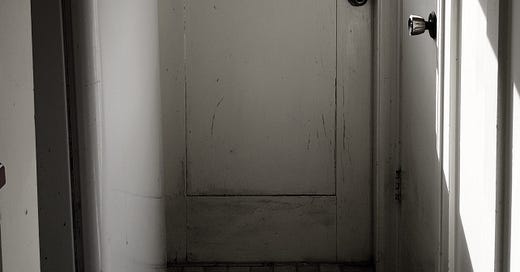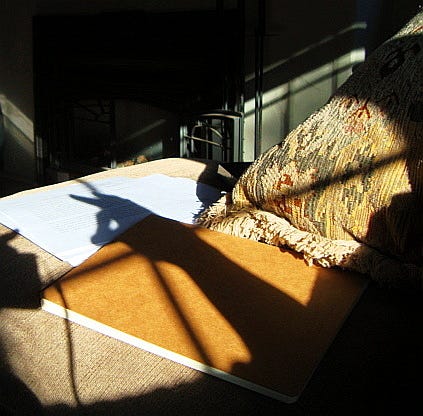Waiting for . . .
#126: Waiting, Shadow Puppet, Jef Bourgeau, Matt Ricardo, Artists and Lit., Rupy C. Tut, Jamie Chan, Ringo of Bradford Beach, Enji, and Carola Baer.
HERE & NOW
I’m waiting for something, but I’m not sure what it is. Something about the end of the year, perhaps. Something about high rents and the ever-present possibility of moving on. Something about friends passing away and how easily one walks away from this life. Something about wars seemingly at such a distance that we can forget about them, yet somehow they are connected to everything we do.
I’ve become so expert at distracting myself that I only notice this glitch in time once in awhile. Then again, perhaps it’s “waiting” only if you decide it is.
ART
RABBIT HOLE
Jef Bourgeau:
I first encountered Jef Bourgeau’s art several days ago in a post by “Robert C. Pettit” for a Facebook group, “The Other Side of Art,” which has 529.2K members. Pettit had posted an image of Bourgeau’s “James River Trail (Blue Ridge)” (2023). It’s a beautiful, “painterly” work of landscape art in richly saturated colors that is getting many “likes” and comments. These are, however, peppered with notes of confusion, frustration, admiration, anger, and questions.
Part of the confusion boils down to the fact that the “painterly” art was not painted. They are photographs altered by computer or AI. Another issue is that it’s difficult to find the artist’s website, and pin down exactly who this is. Some sites identify Bourgeau as an interventionist and conceptual artist, director of the Museum of New Art (MONA), of Detroit’s artCORE, and co-founder of the Detroit Center for Contemporary Photography. Other sites seemingly related to him turn out to be about (maybe?) someone else’s work—someone (or multiple someones)1 with a different name—and occasionally similar bios.
He has been accused of being a “shameless self-promoter,” known for challenging the concept of “museum” and hierarchies of art culture. His mostly photographic and digital art appears in museums and art galleries, but also on platforms often used by struggling artists: SaatchiArt, Behance, Artsy, and Society6, among others. You can purchase one of his mugs for $15, or a print of his work on a pillow or shower curtain. I bring this up because I’ve got some items on RedBubble2 and sometimes I wonder if one can use these platforms—often accused of taking advantage of struggling artists—in ways that are more “interesting” and subversive than what was intended.
In an interview with Arthrob in 2001, Bourgeau briefly talks about what’s behind all these satirical cons and interventions.
“I wanted to show that what is or isn't art is no longer clear. I did a phony museum show with work on the wall, and small reproductions of it all in a display case. I hired a person to sit behind the display, read a book and be obnoxious. I was playing with the notion of what museums were becoming and what and who decides art.” —Jef Bourgeau
More can be learned about the artist in his User’s Manual.
Variety performer, juggler, and “extraordinary gentleman,” Matt Ricardo was recently diagnosed, in his 50s, as autistic. Initially, he didn’t think that stimming might apply to him. But after giving it some thought, he realized that he had made a career out of it:
“14 Contemporary Artists on How Reading Influences Their Work” (in Lit Hub).
Rupy C. Tut creates dreamlike paintings using her handmade pigments and focusing on issues of displacement, migration, belonging, and gender. She’s also a calligrapher and miniature painter:
Jamie Chan’s art focuses on “mundane marginalia” of life like baseball cards and small, handmade artist books made of ads, post-its, poems, and paintings. She also attends to issues of labor, learning, and the ecology of making art. Her essay on Bernice Bing’s art is a reflection on the artist’s process as well as communities and relationships that can support—or hinder—the artist.
“With little time to paint, I had to become more practical in how the paint was applied and decisions were made, breaking down steps and layers in advance and knowing what was achievable in a 2-hour window. Most of the 2 hours would be spent looking, then I would strategize a few marks in order to spiritually move on with my life. I would wake up and brush my teeth near the painting before work. Later, digesting my dinner and listening to music, I would look and paint. Naturally, this shift of day to night energy would become fused into the paintings, making them into accumulations of small transitions and about this version of time” -Jamie Chan, regarding her “Lettuce Makes You Tired” exhibit (from Artists Commit).
“Meet Ringo, the star, artist, and friend of Bradford Beach” (article and podcast from WUWM 89.7 fm radio).
SOUNDINGS
Waiting for Godard, by Jef Bourgeau:
Mongolian jazz singer Enji tells stories of her family and her upbringing:
Enji singing live at Birdland in Hamburg:
Lost and found: “Vocalist teacher mother” Carola Baer’s forgotten and only rough and “raw” copy of her album, “Story of Valerie,” was found by a stranger 25 years later in a Goodwill tape bin in Portland by a music collector. He loved her music and contacted Carola on Facebook. Carola’s father, Ruben Metropian, was the sole survivor of a family killed in the 1915 Armenian genocide. Her music has been described as “gothic” and “Lynchian.” Thanks to Clive Thompson’s LF (Linkfest) for pointing me to Baer’s work. Hear her music on Bandcamp and read the article on Carola Baer in Monorail.
Thanks for reading/listening to Eulipion Outpost. As always, special thanks to my supporters for donations to my Ko-fi!
I have a LinkTree now, so you can check out my other sites all in one location.
If you haven’t already, please subscribe—still free!
For example, Stig Eklund, Reena Spaulding, Jane Speaks, Billy Conklin, and more.
I haven’t updated it in several years. Designing for various items was by turns fun and tedious.






